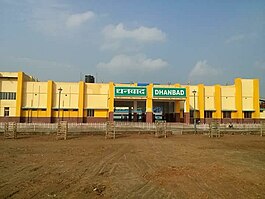This article needs additional citations for verification. (December 2009) |
Grand Chord is part of the Howrah–Gaya–Delhi line and Howrah–Prayagraj–Mumbai line. It acts as a link between Sitarampur, (Asansol), (West Bengal) and Pt. Deen Dayal Upadhyay Junction, (Uttar Pradesh), previously known as Mughalsarai Junction, and covers a stretch of 450.7 km (280.1 mi).[1] The Coal India Corridor line that branches off from Dhanbad Junction and rejoins the Grand Chord at Son Nagar Junction is another major coal loading hub. It is a fully electrified, quadruple line section from Pt. Deen Dayal Upadhyay to Son Nagar and double line section from Son Nagar to Sitarampur . There are plans to triple the lines from Son Nagar to Dhanbad to accommodate the increasing traffic. . The entire line lies under the jurisdiction of three divisions, Mughalsarai railway division, Dhanbad railway division and Asansol railway division. The Grand chord section is the lifeline of the country, 2nd busiest railway section of India after Ghaziabad, Uttar Pradesh to Pt. Deen Dayal Upadhyay Junction, Uttar Pradesh (previously known as Mughalsarai Junction) Main Line section, on which coal, steel and other important goods are moved from Eastern section to Western and Northern sections of the country. In the down direction, the traffic consists of mostly food grains, fertilizers and empty wagons for coal loading in the Jharkhand and West Bengal coal fields. Pt. Deen Dayal Upadhyay Junction is a transit division and the main objective is to maintain mobility of high density traffic. The present capacity of the Grand Chord is being optimally utilized. Traversing through Chota Nagpur Plateau of Jharkhand as well as parts of the fertile Gangetic plains of Bihar, the Grand Chord covers a stretch of 450.7 km (280.1 mi). The Grand Chord is renowned for its remarkable controlling of passenger traffic, despite being burdened with freight traffic.
The railways first came to eastern India in 1854, and the Calcutta–Delhi railway link, with a distance of more than 1,642 km (1,020 mi), became operational by 1866. With the increase in traffic it became necessary to construct an alternative route.
With this in view, the Grand Chord section was planned. The Grand Chord section was opened in December 1906 by Lord Minto, then Viceroy and Governor-General of India with a function at Gujahandi.[1] With the opening of the Grand Chord route, the distance between Calcutta and Delhi was reduced by 192 km (119 mi). The cost of construction was around ₹415 lakh (equivalent to ₹14 billion or US$170 million in 2023).[2]
The Grand Chord section is critically important even today, handling major passenger trains on the Howrah–Delhi route, particularly all the Rajdhani Expresses from Howrah, Bhubaneswar and Ranchi and the entire freight traffic, particularly coal, handled by the Dhanbad division of East Central Railway.
- ^ a b "The Grand 'old' Chord". The Hindu. 4 December 2006.
- ^ "Grand rerun of Raj rail route - Railways enact Lord Minto's flag-off at Gujhandi to celebrate 100 years of Dhanbad-Gaya chord line". The Telegraph. Kolkata. 7 December 2006. Archived from the original on 9 January 2011.
